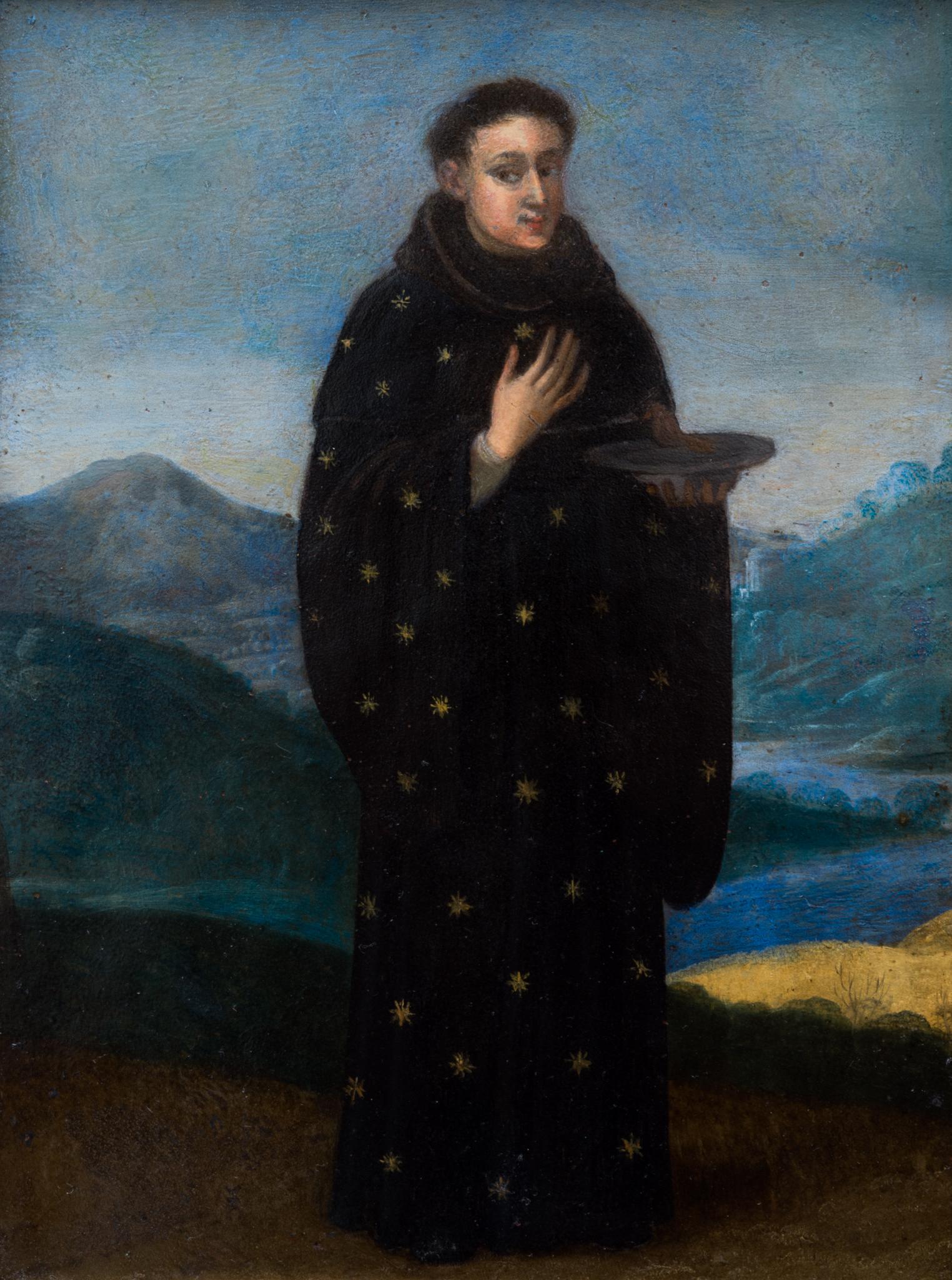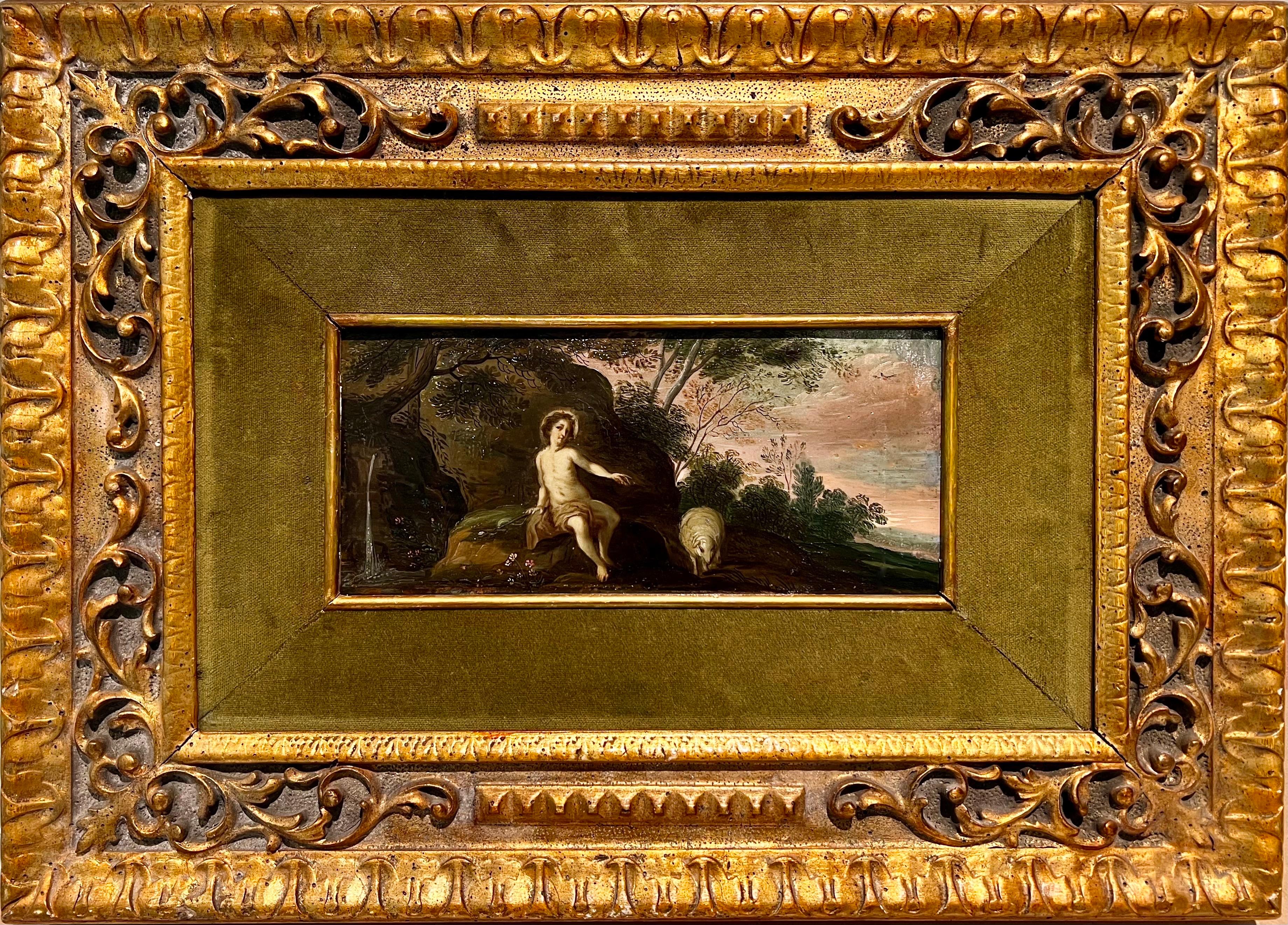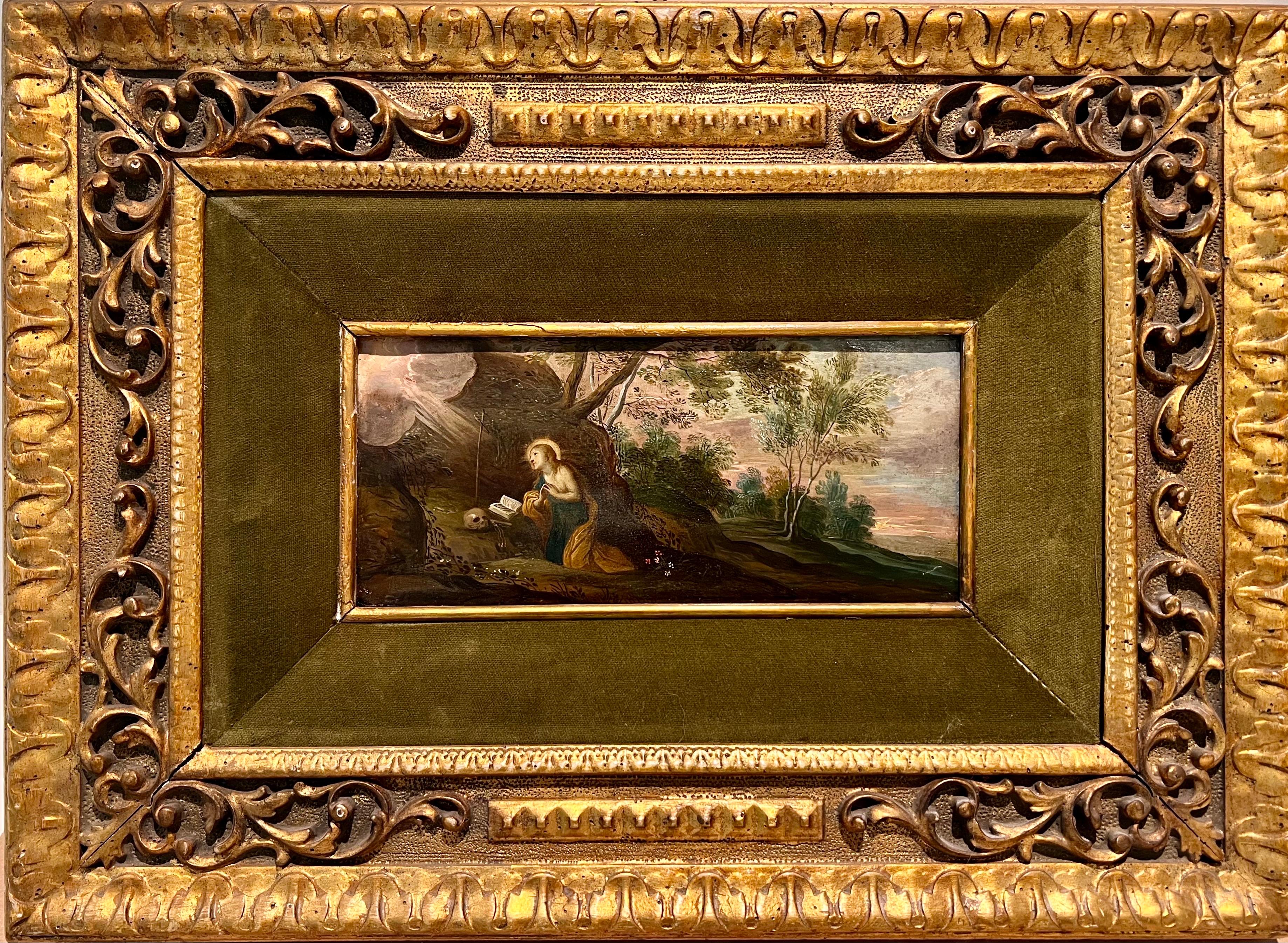Items Similar to Allegory of Abundance
Want more images or videos?
Request additional images or videos from the seller
1 of 4
Jan Brueghel the YoungerAllegory of Abundancec. 1630
c. 1630
About the Item
Painted in collaboration with Hendrick van Balen (Antwerp, 1575 – 1632).
Provenance: Private Collection, Uruguay, since the 1930s.
The eldest son of Jan Breughel the Elder, Jan the Younger trained with his father in Antwerp before setting off for Italy with his childhood friend Anthony van Dyck around 1620. He returned in 1625, becoming a member of the Antwerp painter’s guild (he would become Dean in 1630) and taking over his recently deceased father’s active and successful studio. While he remained active in his native city throughout his long career, his clients came from across Europe and included the Austrian and French courts. The subject matter of his paintings was varied, although he is best known for his idealized landscapes which might feature villages, as well as his allegories and mythological scenes, often made in collaboration with the specialists in figure painting, such as in the present example. Brueghel’s landscape—characterized by a meticulous handling of receding space and populated with beautifully-observed animals, fruits, flowers, and other natural elements—here serves as the setting for a meeting of gods and goddesses accompanied by a satyr, nymphs, and winged putti.
This work is a newly discovered and version of a composition treated on at least two other occasions by Brueghel. The best known is that in National Gallery in Prague with figures by Hendrick van Balen (Fig. 1), while another panel of similar dimensions with figures by Ambrosius Francken the Younger is in a private collection in New York (Fig. 2). Our painting is slightly larger than those two and is distinguished both by its copper support and more expansive treatment of the trees and sky across the top of the painting. As is typical of Jan Brueghel the Younger’s collaborative efforts, van Balen was responsible for the principal figures, while Brueghel painted the landscape, still-life elements, and staffage.
The subject of the work has been variously titled throughout the scholarly literature. For Gustav Glück it was an Allegory of Autumn; Klaus Ertz termed it an Allegory of Abundance; and Bettina Werche catalogued it as Bacchus, Venus, and Ceres. It may properly be considered all three. The harvest deities of Bacchus and Ceres flank the goddess of love Venus and well-illustrate the motto Sine Cerere et Baccho friget Venus (“Without Bacchus and Ceres, Venus grows cold”)—a quotation from the Roman dramatist Terence, suggesting that love disappears without the stimulus of wine and food. As Bacchus, the wine god, and Ceres, the goddess of agriculture, are associated with the bounty of the autumn harvest, their presence—in the context of the richness of the vegetation, produce, fruits, and flowers depicted—make the painting both an allegory of the season, and, more broadly, one of Abundance.
Brueghel was a master of creating a microcosm of the world—here encompassing both the earthly and the godly—in the limited space of a cabinet picture. The composition is created from two divergent diagonals that begin in the center foreground and receipt to the outer edges of the painting, pointing towards two distant landscape views punctuated by a pink and blue tinged sky. The mass of dense trees executed in earthy brown and green hues in the center of the middle-ground serves as a backdrop to the figures in the foregrounds and offsets the rich colors of their garments. These sophisticated compositional devises serve to create an attractive image that presents engaging passages of visual interest throughout.
Dr. Klaus Ertz has confirmed Jan Brueghel the Younger authorship of the painting, with figures by Hendrick van Balen, upon firsthand inspection (certificate of 7 April 2022). Ertz dates the work ca. 1630, shortly after Breughel’s return from Italy in 1625.
- Creator:Jan Brueghel the Younger (1601 - 1678, Flemish)
- Creation Year:c. 1630
- Dimensions:Height: 29.88 in (75.9 cm)Width: 41.25 in (104.78 cm)
- Medium:
- Movement & Style:
- Period:
- Condition:
- Gallery Location:New York, NY
- Reference Number:1stDibs: LU10210793482

About the Seller
5.0
Recognized Seller
These prestigious sellers are industry leaders and represent the highest echelon for item quality and design.
Established in 1997
1stDibs seller since 2012
17 sales on 1stDibs
Typical response time: 11 hours
- ShippingRetrieving quote...Ships From: New York, NY
- Return PolicyThis item cannot be returned.
More From This SellerView All
- A WolfLocated in New York, NYProvenance: The Marchesi Strozzi, Palazzo Strozzi, Florence Sale, Christie’s, London, May 20, 1993, lot 315, as by Carl Borromaus Andreas Ruthart...Category
17th Century Old Masters Animal Paintings
MaterialsPaper, Canvas, Oil
- View of St. John’s Cathedral, AntiguaLocated in New York, NYProvenance: Robert Hollberton, Antigua, ca. 1841 Private Collection, New York The present painting depicts Old St. John’s Cathedral on the island of Antigua. The church was erected in the 1720s on the designs of the architect Robert Cullen. It measured 130 feet by 50 feet with north and south porches 23 x 20 ½ feet. The tower, 50 feet high with its cupola, was added in 1789. The church was elevated to the status of a cathedral, but disaster struck in the form of an earthquake that destroyed the building on 8 February 1843. A memorandum of that date relates the event: “On Wednesday, 8th February, 1843, this island was visited by a most terrific and destructive earthquake. At twenty minutes before eleven o’clock in the forenoon, while the bell was ringing for prayers, and the venerable Robert Holberton was in the vestry-room, awaiting the arrival of persons to have their marriage solemnized, before the commencement of the morning service, the whole edifice, from one end to the other, was suddenly and violently agitated. Every one within the church, after the first shock, was compelled to escape for his life. The tower was rent from the top to the bottom; the north dial of the clock precipitated to the ground with a dreadful crash; the east parapet wall of the tower thrown upon the roof of the church; almost the whole of the north-west wall by the north gallery fell out in a mass; the north-east wall was protruded beyond the perpendicular; the altar-piece, the public monument erected to the memory of lord Lavington, and the private monuments, hearing the names of Kelsick, Warner, Otley, and Atkinson, fell down piecemeal inside; a large portion of the top of the east wall fell, and the whole of the south-east wall was precipitated into the churchyard, carrying along with it two of the cast-iron windows, while the other six remained projecting from the walls in which they had been originally inserted; a large pile of heavy cut stones and masses of brick fell down at the south and at the north doors; seven of the large frontpipes of the organ were thrown out by the violence of the shock, and many of the metal and wooden pipes within displaced; the massive basin of the font was tossed from the pedestal on which it rested, and pitched upon the pavement beneath uninjured. Thus, within the space of three minutes, this church was reduced to a pile of crumbling ruins; the walls that were left standing being rent in every part, the main roof only remaining sound, being supported by the hard wood pillars.” The entrance from the southern side into the cathedral, which was erected in 1789, included two imposing statues, one of Saint John the Divine and the other of Saint John the Baptist in flowing robes. It is said that these statues were confiscated by the British Navy from the French ship HMS Temple in Martinique waters in 1756 during the Seven Years’ War and moved to the church. The statues are still in situ and can be seen today, much as they appeared in Bisbee’s painting, but with the new cathedral in the background (Fig. 1). Little is known of the career of Ezra Bisbee. He was born in Sag Harbor, New York in 1808 and appears to have had a career as a political cartoonist and a printmaker. His handsome Portrait of President Andrew Jackson is dated 1833, and several political lithographs...Category
19th Century Old Masters Landscape Paintings
MaterialsOil, Canvas
- Two Scenes of Diana and Actaeon (a pair)By Giovanni Battista ViolaLocated in New York, NYProvenance: Robert L. and Bertina Suida Manning, New York, until 1996 Private Collection, USA Giovanni Battista Viola was born in Bologna a...Category
17th Century Baroque Landscape Paintings
MaterialsCopper
- Ezekiel in the Valley of Dry BonesBy Philip Burne-JonesLocated in New York, NYProvenance: Christie’s, London, 3 March 1922, lot 46 (with The Tower of Babel); James Nicoll Private Collection Sotheby’s, London, 29 March 1983, lot 157 Private Collection, New Yo...Category
Late 19th Century Victorian Figurative Paintings
MaterialsOil, Canvas
- Job Cursed by His WifeBy Giovanni Battista LangettiLocated in New York, NYProvenance: Alfred (1883-1961) and Hermine Stiassni (1889-1962), Brno, Czech Republic, by 1925; thence London, 1938-1940; thence Los Angeles, 1940-1962; thence by descent to: Susanne Stiassni Martin and Leonard Martin, San Francisco, until 2005; thence by descent to: Private Collection, California Exhibited: Künstlerhaus, Brünn (Brno), 1925, as by Ribera. “Art of Collecting,” Flint Institute of Art, Flint, Michigan, 23 November 2018 – 6 January 2019. Literature: Alte Meister...Category
1670s Old Masters Paintings
MaterialsCanvas, Oil
- Portrait of a Lady with a ChiqueadorLocated in New York, NYProvenance: Torres Family Collection, Asunción, Paraguay, ca. 1967-2017 While the genre of portraiture flourished in the New World, very few examples of early Spanish colonial portraits have survived to the present day. This remarkable painting is a rare example of female portraiture, depicting a member of the highest echelons of society in Cuzco during the last quarter of the 17th century. Its most distinctive feature is the false beauty mark (called a chiqueador) that the sitter wears on her left temple. Chiqueadores served both a cosmetic and medicinal function. In addition to beautifying their wearers, these silk or velvet pouches often contained medicinal herbs thought to cure headaches. This painting depicts an unidentified lady from the Creole elite in Cuzco. Her formal posture and black costume are both typical of the established conventions of period portraiture and in line with the severe fashion of the Spanish court under the reign of Charles II, which remained current until the 18th century. She is shown in three-quarter profile, her long braids tied with soft pink bows and decorated with quatrefoil flowers, likely made of silver. Her facial features are idealized and rendered with great subtly, particularly in the rosy cheeks. While this portrait lacks the conventional coat of arms or cartouche that identifies the sitter, her high status is made clear by the wealth of jewels and luxury materials present in the painting. She is placed in an interior, set off against the red velvet curtain tied in the middle with a knot on her right, and the table covered with gold-trimmed red velvet cloth at the left. The sitter wears a four-tier pearl necklace with a knot in the center with matching three-tiered pearl bracelets and a cross-shaped earing with three increasingly large pearls. She also has several gold and silver rings on both hands—one holds a pair of silver gloves with red lining and the other is posed on a golden metal box, possibly a jewelry box. The materials of her costume are also of the highest quality, particularly the white lace trim of her wide neckline and circular cuffs. The historical moment in which this painting was produced was particularly rich in commissions of this kind. Following his arrival in Cuzco from Spain in the early 1670’s, bishop Manuel de Mollinedo y Angulo actively promoted the emergence of a distinctive regional school of painting in the city. Additionally, with the increase of wealth and economic prosperity in the New World, portraits quickly became a way for the growing elite class to celebrate their place in society and to preserve their memory. Portraits like this one would have been prominently displayed in a family’s home, perhaps in a dynastic portrait gallery. We are grateful to Professor Luis Eduardo Wuffarden for his assistance cataloguing this painting on the basis of high-resolution images. He has written that “the sober palette of the canvas, the quality of the pigments, the degree of aging, and the craquelure pattern on the painting layer confirm it to be an authentic and representative work of the Cuzco school of painting...Category
17th Century Old Masters Paintings
MaterialsCanvas, Oil
You May Also Like
- River Landscape with Shepherds and Architecture, a painting by Jan van BunnikBy Jan van BunnikLocated in PARIS, FRThis painting has been the subject of a study by the art historian Fabrizio Dassie (available on request), confirming its inclusion in Jan van Bunnik’s corpus. In this painting, Ja...Category
Late 17th Century Old Masters Landscape Paintings
MaterialsCopper
- Old Master Painting, Flemish School from 1600s, Saint Nicholas of TolentinoLocated in Stockholm, SEThis small Flemish painting, measuring only 24.5 x 18.5 cm and executed on a copper plate, depicts Saint Nicholas of Tolentino. Created in the 17th century, the artist remains unknow...Category
17th Century Old Masters Landscape Paintings
MaterialsCopper
- Landscape With Pan and Syrinx, Flemish School From the 1600s, Oil on CopperLocated in Stockholm, SEFlemish School, 1600s Landscape With Pan and Syrinx painted around the 1600s oil on copper 19 x 23.5 cm frame 29 x 34 cm Hand-made oak frame by Swedish frame maker Christer Björkma...Category
17th Century Old Masters Landscape Paintings
MaterialsCopper
- The Adoration of the Magi by Joseph van BredaelLocated in New Orleans, LAJoseph van Bredael 1688-1739 Flemish The Adoration of the Magi Oil on copper Painted on copper and exhibiting an exquisite luminosity, this exceptional painting...Category
Late 17th Century Old Masters Figurative Paintings
MaterialsCopper
- 17th century religious old master oil - St. John the Baptist in a landscapeLocated in Antwerp, BE17th century oil on copper - St. John the Baptist in a landscape with the Lamb The very finely and delicately painting depicts St. John in a vast landscape, with a vibrant sunset co...Category
17th Century Old Masters Figurative Paintings
MaterialsCopper
- 17th century religious old master oil - Penitent Magdalene in a landscapeLocated in Antwerp, BE17th century oil on copper - Penitent Magdalene in a landscape The very finely and delicately painting depicts Mary Magdalene in a vast landscape, with a vibrant sunset colouring th...Category
17th Century Old Masters Figurative Paintings
MaterialsCopper
Recently Viewed
View AllMore Ways To Browse
Antique Receipt
Antique Green Picture Frames
Wine Harvest
Old Black Painted Cabinet
Antique Food Cabinet
Winged Goddess
Italian Oil Painting Wine
Italian Cabinet Landscape
Van Dyck Oil
Black Wine Cabinet
Nymph Oil Painting
7 Gods
French 17th C Paintings
Antique Copper Cabinet Handles
Putti Oil
Still Life Flowers Wine
Brueghel Painting
Oil On Copper Painting 17th Century





